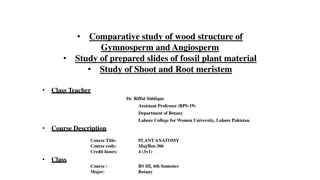Watching Seagrass Breathe
Join marine biologist Alyson Hall in her seventh-grade science project to study seagrass ecosystems. Discover the importance of seagrasses, the differences between seagrasses and seaweeds, and the two species of seagrass found in the Chesapeake Bay. Engage in activities like surveying seagrass, meas
0 views • 31 slides
Exploring Seed Plant Diversity and Adaptations
Delve into the realm of seed plants, uncovering their unique adaptations for reproduction, their phylogeny with gymnosperms and angiosperms, and the diversity within gymnosperms such as conifers, cycads, gingkophytes, and gnetophytes. Discover the evolutionary success of seed plants through their wa
5 views • 23 slides
Understanding Phylogeny and Evolution in Angiosperms
Phylogeny is the study of evolutionary relationships among organisms, depicted in phylogenetic trees based on shared characteristics. This overview delves into terms like homology, analogy, monophyly, and co-evolution in angiosperms with an emphasis on taxonomy, systematics, and the evolutionary his
1 views • 25 slides
Comparative Study of Wood Structure in Gymnosperms and Angiosperms
This course in Plant Anatomy at Lahore College for Women University delves into the detailed examination of wood structures in Gymnosperms and Angiosperms. It involves analyzing prepared slides of fossil plant material, studying shoot and root meristems, and understanding the differences between har
0 views • 9 slides
Understanding Seed Plants: Gymnosperms and Angiosperms
Learn about the adaptations that allow seed plants to reproduce without open water, the importance of seeds, and the differences between gymnosperms and angiosperms. Explore how gymnosperms carry out fertilization without water in their life cycle. Images included.
0 views • 5 slides
Origin and Evolution of Angiosperms: Insights into Their Phylogenetic Origins
Undisputed fossil records reveal the significant appearance and diversification of angiosperms during the Mesozoic era. The debate on the origin of angiosperms revolves around their monophyletic versus polyphyletic nature. While some argue for a monophyletic origin based on shared characteristics, o
1 views • 5 slides
Workshop on T.Y.B.Sc. Botany Revised Syllabus Semester VI at R.P. Gogate College of Arts & Science and R.V. Jogalekar College of Commerce
This workshop, held on 18th Feb 2019, introduced the revised syllabus for Semester VI of the T.Y.B.Sc. Botany program at R.P. Gogate College of Arts & Science and R.V. Jogalekar College of Commerce in Ratnagiri. The syllabus covers topics such as plant diversity, form and function, current trends in
0 views • 26 slides
Understanding Seed Anatomy and Germination Processes
Explore the anatomy of seeds, including taxonomic classes like angiosperms and gymnosperms, subclasses within angiosperms, and components of a seed such as the embryo, endosperm, and seed coat. Learn about seed germination conditions, dormancy, and factors like favorable temperature and scarificatio
0 views • 17 slides
Evolution of Land Plants: Colonization and Adaptations
Land plants evolved from Charophyceans, the closest algal relative, adapting to life on land through characteristics like multicellularity, photosynthesis, and specialized reproductive cycles. They diversified into four main groups: Bryophytes, Pteridophytes, Gymnosperms, and Angiosperms, each with
0 views • 12 slides
Understanding Angiosperms: Classification and Reproduction
Angiosperms reproduce sexually through flowers, with their ovaries developing into fruits that protect and disperse seeds. Classification of angiosperms includes monocots and dicots based on the number of seed leaves. They are categorized by characteristics like stem composition and growing seasons
0 views • 4 slides
Understanding Plant Classification and Characteristics
Discover the classification of plants based on their structures and characteristics, including vascular vs. nonvascular plants, seed plants vs. seedless plants, and the definitions of angiosperms, gymnosperms, dicots, and monocots. Learn about the history of plant classification and how plants are g
0 views • 27 slides
Plant Reproduction and Life Cycles in Biology II for Non-Majors
Explore the complex processes of plant reproduction, life cycles, and the alternation of generations in biology. From the fusion of male and female gametes to the development of sporophytes and gametophytes, delve into the stages and structures involved in the reproduction of gymnosperms and angiosp
0 views • 25 slides
Understanding the Types of Endosperm in Angiosperms
Endosperm is the nutritive tissue formed in angiosperms through triple fusion, serving to nourish the embryo. There are three main types of endosperm: Nuclear, Cellular, and Helobial, each characterized by distinct modes of development. Nuclear endosperm features repeated division of the primary nuc
0 views • 16 slides
Understanding Flower Dissection and Reproduction Process
Angiosperms are seed-bearing plants that produce flowers containing essential and accessory organs for reproductive functions. The stamen and pistil play key roles in the male and female reproductive processes, leading to fertilization and seed formation. Pollination, germination, and fruit developm
0 views • 14 slides
Understanding Plant Evolution and Characteristics
Plants colonized land through various adaptations such as multicellularity and photosynthesis. They exhibit characteristics like chlorophyll, cellulose cell walls, and apical meristems. Plant evolution includes alternation of generations, with gametophytes and sporophytes undergoing meiosis and mito
0 views • 15 slides














